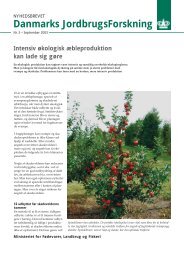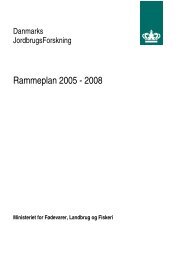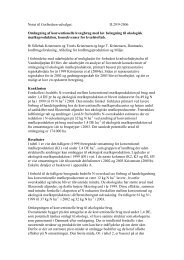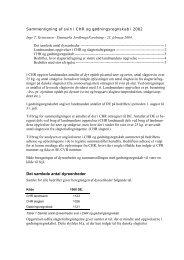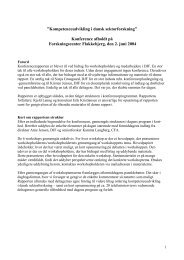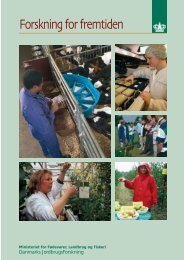Reproduction performances and conditions of group-housed non ...
Reproduction performances and conditions of group-housed non ...
Reproduction performances and conditions of group-housed non ...
Create successful ePaper yourself
Turn your PDF publications into a flip-book with our unique Google optimized e-Paper software.
- Paper I -<br />
gonadotrophins (LH, FSH) (Hughes & Pearce, 1989). Both LH <strong>and</strong> FSH act on the ovaries<br />
to stimulate the development <strong>of</strong> the pre-ovulatory follicle (Foxcr<strong>of</strong>t & Hunter, 1985). LH is<br />
furthermore essential for the maintenance <strong>of</strong> early pregnancy in the pig (Peltoniemi et al.,<br />
1995) why lower pregnancy rate as a consequence <strong>of</strong> restricted feed intake may be due to a<br />
reduction in LH pulse frequency (Peltoniemi et al., 2000). The negative effect <strong>of</strong> high feed<br />
intake the first three days in pregnancy on embryo survival is believed to be caused by an<br />
increase in hepatic blood flow <strong>and</strong> metabolic clearance rate <strong>of</strong> progesterone, as a consequence<br />
<strong>of</strong> rapid weight gain, followed by a decrease in plasma level <strong>of</strong> progesterone<br />
(Hughes & Pearce, 1989; Foxcr<strong>of</strong>t, 1997). Progesterone is the primary director <strong>of</strong> uterine<br />
development <strong>and</strong> secretion (Geisert & Yelich, 1997) <strong>and</strong> therefore a change in plasma level<br />
<strong>of</strong> progesterone could imply detrimental consequences for embryo survival as indicated in a<br />
study by Pharazyn et al. (1991). Progesterone is secreted from Corpus Luteum <strong>and</strong> because<br />
the pig is polyovulatory, it is suggested that it is unlikely that the plasma progesterone concentration<br />
may get below some essential threshold after the first three to four days <strong>of</strong> pregnancy<br />
(Foxcr<strong>of</strong>t, 1997).<br />
The statement, that reproduction may be influenced by nutrition is further supported by<br />
observations <strong>of</strong> wild sows. Matschke (1964 q.f. Graves, 1984) reported that European wild<br />
sows were anoestrous during years <strong>of</strong> small quantity <strong>of</strong> mast <strong>and</strong> similar did Mauget (1981)<br />
report that the timing <strong>of</strong> breeding season was influenced by the amount <strong>of</strong> mast available.<br />
When looking upon the results from the studies reviewed, although it does not provide a<br />
clear picture, it seems that pregnancy rate <strong>and</strong> litter size can be influenced by energy intake<br />
in the <strong>non</strong>-lactative period. However, the question, which remains to be answered, is<br />
whether variation in energy intake between female pigs in commercial <strong>group</strong>-<strong>housed</strong> systems<br />
reaches magnitudes large enough to impair the litter size <strong>and</strong> pregnancy rate?<br />
Andersen et al. (1999) observed that low ranking sows only spent about half as much time<br />
at the trough at feeding compared to high ranking sows (40 vs. 90 % <strong>of</strong> observations) in a<br />
<strong>group</strong> <strong>of</strong> pregnant sows. Although low ranking sows may be able to increase their eating<br />
rate when competition for feed is high, as suggested by Brouns & Edwards (1994), it is<br />
likely that the energy intake <strong>of</strong> the low ranking sows has been considerably lower than the<br />
energy intake <strong>of</strong> the high ranking sows. Mendl et al. (1992) observed that low <strong>and</strong> <strong>non</strong>e<br />
success primaparous sows (the sows were divided into three <strong>group</strong>s according to their ability<br />
to displace other sows in agonistic interactions) had significant lower weight gain than<br />
high success primaparous sows (approximately 7, 9 <strong>and</strong> 19 kg, respectively in one month)<br />
in their 7 th week <strong>of</strong> pregnancy. As Mendl et al. (1992) point out, the lower weight gain in<br />
the low ranking sows is not necessarily a result <strong>of</strong> lower feed intake only but perhaps a<br />
combination <strong>of</strong> lower feed intake <strong>and</strong> an elevated expenditure <strong>of</strong> energy for maintenance as<br />
39




